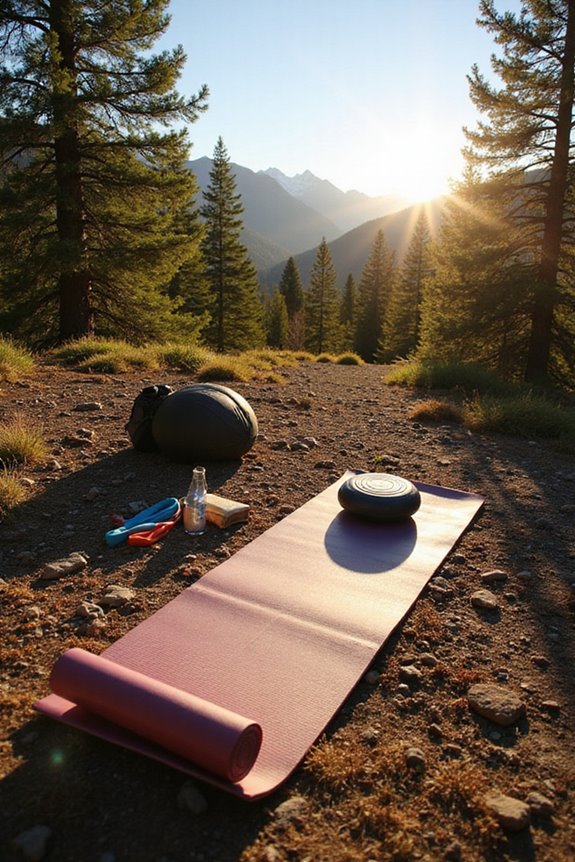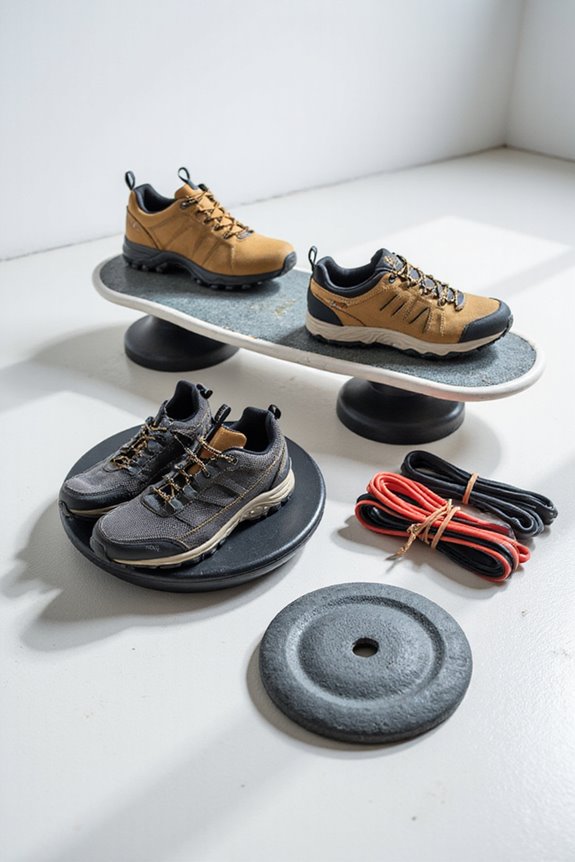To improve balance for outdoor sports, practice core stability and agility through fun activities. Try trail running to connect with nature while enhancing proprioception. Engage in single-leg balance exercises to build confidence, and add dynamic drills to boost your response times. Using balance tools like boards and pads can spice up your routine while preventing injuries. So, if you’re ready to step up your game, there’s a lot more waiting to be uncovered.
Key Takeaways
- Practice trail running to enhance proprioception and develop micro-adjustments for varied terrains.
- Incorporate single-leg balance exercises to boost stability and confidence in outdoor activities.
- Engage in dynamic balance exercises to improve agility and reduce injury risks during movement.
- Utilize balance tools like boards and discs to challenge stability while enhancing core strength.
- Perform core strengthening and lower-body exercises to promote better stability and control in outdoor sports.
Understanding Balance in Outdoor Sports
When it comes to outdoor sports, balance is not just a nice-to-have skill; it’s essential, and mastering it can make the difference between soaring through a mountain trail or taking an unexpected tumble into a bush. Understanding balance mechanisms involves keeping the body’s center of gravity steady over its base of support, whether standing still or zipping down a trail. This skill relies heavily on sensory integration, pulling together visual, vestibular, and somatosensory inputs. Think of it as a team effort: your eyes spot that rock, your inner ear senses your head’s tilt, and your muscles react to keep you upright. With outdoor environments constantly changing, mastering balance can mean the difference between a thrilling ride and an awkward faceplant.
Outdoor Activities to Enhance Balance

Balance isn’t just a skill; it’s an adventure waiting to unfold, especially in the great outdoors. Engaging in activities like trail running or obstacle navigation can transform the way one interacts with nature. Imagine racing down a rocky trail, every step a dance with the ground beneath. Walking on uneven surfaces sharpens proprioception, while dodging branches and boulders trains essential micro-adjustments. And let’s not forget about the thrill of single-leg balance exercises—standing tall on one leg while trying to catch a frisbee, anyone? These playful challenges not only boost confidence but also reduce the risk of nasty falls. So, lace up those shoes, venture outside, and embrace the delightful journey to better balance—your body will thank you!
Dynamic Balance Exercises for Athletes

Dynamic balance exercises play an essential role in shaping an athlete’s performance, and they can be a game-changer during training sessions. By incorporating balance training techniques, athletes enhance their proprioception, which means they become more aware of their body positions in motion. Imagine darting down a field, your body responding quicker to your brain’s commands—thanks to dynamic stability exercises. These workouts not only boost agility but also fortify joint stability, reducing injury risks that can sideline an athlete. Just picture a football player effortlessly shifting direction, all while maintaining control. In just a few weeks, improvements in balance can lead to better power production and cognitive processing, making these exercises crucial for anyone serious about outdoor sports. Additionally, using resistance bands during balance training can provide added resistance and further enhance strength and stability.
Single Leg Balance Training Techniques

Standing on one leg might seem like a simple party trick, but it’s a powerful training technique that can seriously boost outdoor sports performance. Single leg balance techniques enhance agility and stability, essential for skiing, trail running, and hiking. Imagine reaching your free leg forward or sideways while maintaining your balance—it’s a workout for both body and mind! Start with a stable surface, holding for 30 to 60 seconds, then progress to dynamic movements like single leg squats or hops. These exercises not only strengthen stabilizer muscles but also reduce injury risks. Picture yourself gracefully maneuvering uneven terrain, thanks to your newfound balance. Incorporating resistance bands into your training can further enhance strength and stability during these balance exercises. So, embrace the challenge of single leg training—your outdoor adventures will thank you!
Foundational Balance Exercises for Winter Sports

When it comes to winter sports, a solid foundation is key to not just surviving but thriving on the slopes. Core strengthening is essential; exercises like planks and bird dogs build stability, helping to keep the spine aligned while maneuvering tricky terrain. Imagine gliding down a snowy hill, knowing your body is ready for anything! Incorporating dynamic balance drills, such as single-leg jumps or lateral bounds, enhances proprioceptive training, sharpening the brain’s ability to respond to changing conditions. Plus, don’t forget about lower-body strength—squats and step-ups can make those turns feel effortless. By focusing on these foundational exercises, athletes can reduce the risk of falls and enjoy every exhilarating ride down the mountain, feeling confident and balanced. Utilizing resistance bands can further enhance your training by providing effective resistance and versatility in exercises.
Utilizing Balance Tools and Equipment
While many might think balance training is just for gymnasts or tightrope walkers, the truth is, anyone looking to improve their outdoor sports performance can benefit greatly from using balance tools and equipment. Balance boards, for instance, offer incredible balance board benefits by engaging core muscles, making workouts versatile and fun. Users can perform squats, push-ups, or even yoga, all while enhancing stability. Other tools like balance pads and discs focus on proprioceptive training, challenging the body on unstable surfaces. These lightweight devices are easy to use anywhere, adapting to fitness levels. Plus, they’re perfect for injury prevention! Incorporating these tools into a routine not only boosts balance but also adds excitement to workouts, making every session an adventure.
Training Principles for Balance Improvement
Improving balance isn’t just a chore; it’s a journey filled with exciting discoveries and challenges. To commence this adventure, one must embrace dynamic systems theory, which emphasizes the interconnectedness of body movements and balance. This means incorporating core stability exercises, plyometrics, and resistance training. For instance, engaging the core through planks and dynamic movements enhances stability, while jump squats add that zing to your quickness. Balance assessment is key, helping identify strengths and areas for improvement. And remember, blending in flexibility and mobility exercises keeps those joints happy and enhances overall control. With progressive overload and a sprinkle of humor, balance training can be an exhilarating ride, paving the way for outdoor sports success!
Progression Strategies for Effective Balance Training
Mastering balance is like starting a thrilling treasure hunt, where each step reveals new strategies for success. To initiate this adventure, one should begin with basic single-leg stances on solid ground, gradually introducing unstable surfaces like foam pads. Adding dynamic movements, such as lifting an opposite arm or leg, increases the excitement while enhancing balance progression. Incorporating external stimuli, think resistance bands or even friendly pushes, brings real-world stability challenges into play. As confidence builds, participants can explore multi-planar movements and tackle sudden changes, refining their reactive balance. Engaging in sports like trail running or mogul skiing not only solidifies these skills but also proves that balance training can be both effective and fun, ensuring every outdoor adventure becomes memorable!
Frequently Asked Questions
How Often Should I Practice Balance Exercises Weekly?
Frequency recommendations suggest practicing balance routines 2–3 times weekly. Each session should last 10–15 minutes, gradually increasing difficulty to enhance stability, agility, and overall physical performance while minimizing fall risk for maximum benefits.
Can I Improve Balance Without Specialized Equipment?
Ironically, many believe balance requires fancy equipment, yet yoga poses enhance core stability without it. Simple exercises, like one-leg stands, can effectively improve balance, proving that sometimes, less truly is more in fitness.
What Age Should Balance Training Begin?
Balance training should begin in early childhood development, as children reach balance milestones through play and movement. Early interventions enhance coordination, reduce injury risks, and lay a foundation for lifelong balance and stability.
Are There Specific Warm-Ups for Balance Training?
Like a tightrope walker mastering their craft, specific warm-ups for balance training include dynamic stretches and proprioceptive drills. These techniques cultivate stability, enhancing overall coordination and preparing athletes for the unpredictable nature of outdoor sports.
How Do I Track My Balance Progress Effectively?
To track balance progress effectively, one should utilize various balance assessments alongside tracking techniques. Regular evaluations, such as the BESS and SEBT, combined with data analysis and coaching feedback, guarantee thorough monitoring of improvements over time.





